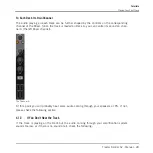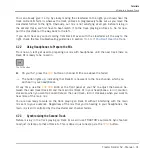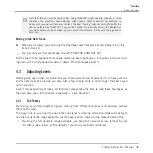
A GAIN/FILTER encoder sits at the top of each channel.
►
Adjust the channel’s
GAIN/FILTER
encoder so that the level displayed on the channel
meter stays in the upper part of the blue area without reaching the red clipping LED.
Note that the channel’s EQ and filter settings also affect the signal level, as well as the possi-
ble FX Unit(s) it is assigned to. Hence, when modifying any of these, you might need to re-
adjust the
GAIN/FILTER
encoder accordingly.
Of course, the artistic side of your tracks should not be overlooked: for tracks with a variable
average level over time (e.g., a track starting with a soft intro), you should consider the loudest
parts of the track when adjusting the channel level.
Matching Levels between Channels
Moreover, in order to avoid any level jump when crossfading between two channels, the aver-
age channel levels should match:
►
Before mixing in a cued channel, adjust its
GAIN/FILTER
encoder so that its channel me-
ter activity roughly matches that of the channel currently on air.
TRAKTOR already does this for you by automatically setting the level for each newly loaded
track to a satisfying value. This so-called “Autogain” feature relies on the gain values ex-
tracted from your tracks. Nevertheless, depending on the particular EQ, filter and FX ap-
plied to the cued track, you might have to double-check the level consistency before you
mix in the track. Moreover, what is important here is the average level of the specific part
of the track that you’re about to mix in.
Checking the Main Level
The signals coming from all channels are mixed together according to the relative levels set by
the channel faders and by the crossfader. This mix is then sent from TRAKTOR’s main output
to the Main section. Below you see a picture of the S2's
MAIN LEVEL
knob.
Tutorials
Adjusting Levels
Traktor Kontrol S2 - Manual - 40
Summary of Contents for TRAKTOR KONTROL S2
Page 1: ...Manual...
















































